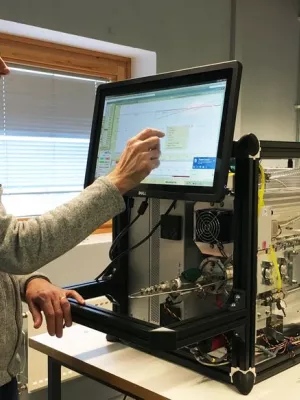
Erik Swietlicki
Professor

A set-up for respiratory tract deposition efficiency measurements (15–5000 nm) and first results for a group of children and adults
Författare
Summary, in English
Exposure to airborne particulate matter is associated with a number of negative health effects ranging from respiratory diseases to systemic effects and cancer. One important factor for understanding the health effects is the individual variation in the respiratory tract deposition of inhaled particles. In this study, we describe an experimental set-up for size-resolved measurements of the lung deposited fraction of airborne particles, covering the diameter range from 15 to 5000 nm. The set-up includes a system for generating a stable aerosol with a sufficiently broad size distribution. We used a scanning mobility particle sizer and an aerodynamic particle sizer to determine particle number and size. The set-up was used to investigate individual differences in the deposition fraction (DF) of particles in the respiratory tract for a group of 67 subjects of both sexes aged 7–70 years. The measured DF was applied to two model aerosols, one representing an urban environment and one a rural environment, and the particle deposition rates were derived (i.e., the deposited amount of particles per unit time). Furthermore, the deposition rates were normalized to lung surface area and body mass – two dose measures that are considered relevant for the health effects of airborne particles. In addition to validation of the set-up, we show that there is a large individual variation in DF, with some subjects having a DF that is more than twice as high as that of others. Although we observe differences in the DF between different subgroups, most individual variation was explained neither by age nor by gender. When normalizing the deposition rates to lung surface area or body mass, the deposition rates of children become significantly higher than those of adults. Furthermore, the individual variability is larger for the lung surface area or body mass normalized deposition rates than for DF.
Avdelning/ar
- NanoLund: Centre for Nanoscience
- Ergonomi och aerosolteknologi
- Kärnfysik
- MERGE: ModElling the Regional and Global Earth system
Publiceringsår
2017-05-01
Språk
Engelska
Sidor
1244-1255
Publikation/Tidskrift/Serie
Aerosol and Air Quality Research
Volym
17
Issue
5
Dokumenttyp
Artikel i tidskrift
Förlag
Taiwan Association for Aerosol Research
Ämne
- Respiratory Medicine and Allergy
Nyckelord
- Aerosols
- Airborne particles
- Deposition efficiency
- Dose rate
- Individual variability
Status
Published
ISBN/ISSN/Övrigt
- ISSN: 1680-8584